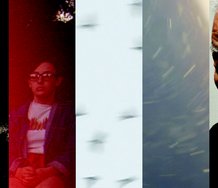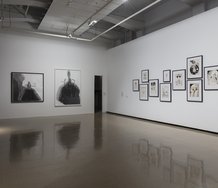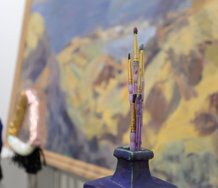Mark Amery – 22 November, 2009
They surround ceramic polyps, which glazed and earthy in colour are more like the pottery we’re most familiar, yet raise the finger to tradition in being in form male and female genitalia – as commonly appears in nature.
Wellington
Lower Life Forms
Madeleine Childs and Philip Jarvis
until 28 November 2009
Visiting judge for the 2009 Portage Awards Scott Chamberlain, a University of Colorado Professor in Ceramics, had the clay community aflutter here apparently for his award of top honours to the bright kooky works of Dunedin artists Jim Cooper and pair Madeleine Childs and Philip Jarvis. Coming from my more general contemporary art perspective the selection is cause for celebration rather surprise. These are artists who shake up hierarchical notions that surround domestic craft objects and play with their relationship to culture and nature in captivating, complex and joyful ways.
Yet even I can admit to some bad taste twinges first seeing Jarvis and Childs’ gaudy box bouquets and giant broaches, with their mad mèlange of forms gone troppo in Lower Life Forms, currently at Wellington’s Mary Newton Gallery. I still find myself struggling with their irregularly shaped brightly colour-soaked foam bases – reminiscent for me of oversized old-fashioned stage food props. Mine is like an instinctive, reactionary repulsion towards aesthetic delinquents in a craft shop – something that passes when you get talking and discover they’re rather engaging, fun and clever.
The work titles are themselves an insult to given cultural hierarchies: Doodahs and Doodads, Thingys and Vegetable Sheep. Materials mix in previously unforgivable ways. Paint-soaked foam squeezes around pottery. Twisted braids of coloured rubber bands dribble through gardens of disparate natural forms, synthetic textures and colours. It would be not unlike a pick n mix meltdown in a candy store - leaving mounds of congealed marbled candy spiked by assorted jagged shelving material – if it weren’t for the fact that the work replicates nature’s own untamed excessiveness.
The arrangements mimic two fantastical low-to-the-ground marine and terrestrial natural groupings from two dissimilar climates: tropical coral reefs and the alpine small low bushes known as vegetable sheep (for their vague resemblance from a distance to the animal). Both exist in squeezed or challenging living spaces. In their compact shapes they provide their own balanced worlds, full of the bulging frictions of growing, replicating and dying. They could be seen to reflect our own fragile low-lying position on a globe.
The most successful are variations on Jarvis and Childs’ Portage winning work (currently showing at Lopdell House, Titirangi). These are coral reefs as overstuffed table settings. Fingers of mirror glass coated white coral artlessly grasp up towards the light like a dying man’s fingers. They rise out of multi-coloured sponge beds, rippling and bulging like some Neapolitan ice cream desert packed full of artificial colours. They surround ceramic polyps, which glazed and earthy in colour are more like the pottery we’re most familiar, yet raise the finger to tradition in being in form male and female genitalia – as commonly appears in nature. Diverse natural forms attempt to overtake, override and live off each other in a way which we would often call culturally undignified.
This is work that reflects that nature is in the constant process of growing up and out, as it is breaking down into powder. While most craft objects identify themselves by their noble stillness, these works are refreshingly alive and sexed - frothing, ejaculating and wiggling.
Another layer I didn’t get until I read their exhibition blurb was that the Doodahs are, like Dane Mitchell’s use of packing materials or Peter Robinson’s play with polystyrene breaking down hierarchies by employing the very material that constrains and cotton wools ceramics. Pottery here is held within its own packing material of foam and rubber bands.
The second major set of works Vegetable Sheep are wallworks that often make use of Egyptian paste to create mounds of repeated marbled patterns. Like overly fertile mosses, they refuse to behave and some contain tangles of number eight wire, which in one case appears yellow pollen coated, nature reclaiming the scraggly remains of the high country farm.
Also reminiscent of the knick-knack and bauble ornaments of another era’s homes, they’re either initially repellent because of this old fashioned ornamental, non-utilitarian quality (like wedding table settings or Race Day hats gone terribly wrong) or they’re everything you thought New Zealand ceramics wasn’t. They’re bright, brash, inelegant and utterly useless. Ugly even. The devil’s answer to a white John Parker vase and American pop excess to European modernist reserve. No wonder it took an American to pick them, they react against everything New Zealand is known for. I fear we may be too timid for them. Besides, they’d be a devil to dust.
The exhibition title Lower Life Forms echoes Jarvis and Child’s interest in what fantastical things might come from unexpected ordinary places. They have more in common with Judy Darragh than any other object-maker I’ve known. Our domestic environments are treated the same as other natural habitats. Jarvis and Childs often work with objects found closest to them domestically (from popcorn kernels to household cleaner bottles). Here an untangled pot scrubber for example is much used to construct fragile marine life forms.
Hats off to Mary Newton Gallery who for five years have drawn attention to artists like this pair and Cooper. Artists who play inventively with the world around them, have little care for divisions of high and low and art and craft, and don’t fit easily into any preexisting boxes.





 Two Rooms presents a program of residencies and projects
Two Rooms presents a program of residencies and projects Advertising in this column
Advertising in this column



This Discussion has 0 comments.
Comment
Participate
Register to Participate.
Sign in
Sign in to an existing account.